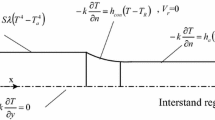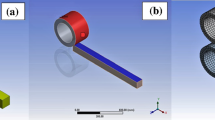Abstract
Commercial aluminum rolling mills operate under very restricted thermomechanical conditions determined from experience and plant trials. In this paper we report results for four-stand tandem mill rolling simulations within and beyond the thermomechanical conditions typical of a rolling mill by plane strain compression (PSC) testing to assess the effect of deformed conditions on the texture of the hot deformed aluminum strip after annealing. A neural network modeling study was then initiated to find a predictive relationship between the observed texture and the thermomechanical parameters of strain, strain rate, and temperature. The model suggested that temperature is the prime variable that influences texture. Such models can be used to evaluate optimal strategies for the control of process parameters of a four-stand tandem mill.
Similar content being viewed by others
References
R.A. Ricks: Philos. Trans. R. Soc. London, 1999, Ser. A, 357, pp. 1513–29.
I. Gutierrez and M. Fuentes: “Influence of the Microstructural Changes Occurring During Steady State Hot Deformation on Static Recrystallization Kinetics and Recrystallized Grain Size of Commercial Aluminum,” Recrystallization 90., Ed., T Chandra TMS, 1990 Warrendale, PA pp. 807–12.
N. Raghunathan, M.A. Zaidi, and T. Sheppard: “Recrystallization Kinetics of Al—Mg Alloys AA 5056 and AA 5083 After Hot Deformation,” Mater. Sci. Technol., 1986, 2, pp. 938–45.
C.M. Sellers, A.M. Irisarri, and E.S. Puchi: “Recrystallization Characteristics of Aluminum—1% Magnesium Under Hot Working Conditions” in Microstructural Control in Aluminum Alloys: Deformation, Recovery, and Recrystallization, E. Henry Chia and H.J. McQeen, ed., The Metallurgical Society/AIME, Warrendale, PA, 1986, pp. 179–96.
H.E. Vatne, T. Furu, R. Orsund, and E. Nes: “Modeling Recrystallization After Hot Deformation of Aluminum,” Acta. Mater., 1996, 44, pp. 4463–73.
E.S. Puchi, J. Beynon, and C.M. Sellars: “Simulation of Hot Rolling Operations on Commercial Aluminum Alloys,” Proc. Int. Conf. On Physical Metallurgy of Thermomechanical Processing of Steels and Other Metals: THERMC ’88,. 1988, I. Tamura, ed., The Iron and Steel Institute of Japan, Tokyo, Japan, 1988, pp. 572–79.
P.D. Hodgson and R.K. Gibbs: “A Mathematical Model to Predict the Mechanical Properties of Hot Rolled C-Mn and Microalloyed Steels,” ISIJ Int., 1992, 32, pp. 1329–38.
R. Sandstrom and R. Lagneborg: “A Model for Static Recrystallization After Hot Deformation,” Acta Metall., 1975, 23, pp. 481–88.
T. Furu, H.R. Shercliff, G.J. Baxter, and C.M. Sellars: “The Influence of Transient Deformation Conditions on Recrystallization During Thermomechanical Processing of an Al-1% Mg Alloy,” Acta Mater., 1999, 47, pp. 2377–89.
H.K.D.H. Bhadeshia, D.J.C. Mackay, and L.E. Svensson: “Impact Toughness of C-Mn Steel Arc Welds—Bayesian Neural Network Analysis,” Mater. Sci. Technol., 1995, 11(10), pp. 1046–51.
S.M. Roberts, J. Kusiak, Y.L. Liu, A. Forcellese, and P.J. Withers: “Prediction of Damage Evolution in Forged Aluminum Metal Matrix Composites Using a Neural Network Approach,” J. Mater. Proc. Technol., 1998, 80–81, pp. 507–12.
G.J. Marshall: “Simulation of Commercial Hot Rolling by Laboratory Plane Strain Compression and its Application to Aluminum Industry Challenges.” Proc. of the Second Symposium of Hot Deformation of Aluminum Alloys II, 1998, ed., T.R. Bieler, L.A. Lalli, and S.R. MacEwen, ed., The Minerals, Metals and Materials Society, Warrendale, PA, 1998, pp. 367–82.
D.J.C. Mackay: “Bayesian Interpolation,” Neural Comput., 1992, 4, pp. 415–47.
D.J.C. Mackay: “Probable Networks and Plausible Predictions-a Review of Practical Bayesian Methods for Supervised Neural Networks,” Network: Computat. Neural Syst., 1995, 6, pp. 469–505.
Author information
Authors and Affiliations
Rights and permissions
About this article
Cite this article
Barat, P., Withers, P.J. Neural network modeling for the prediction of texture evolution of hot deformed aluminum alloys. J. of Materi Eng and Perform 12, 623–628 (2003). https://doi.org/10.1361/105994903322692402
Received:
Revised:
Issue Date:
DOI: https://doi.org/10.1361/105994903322692402




